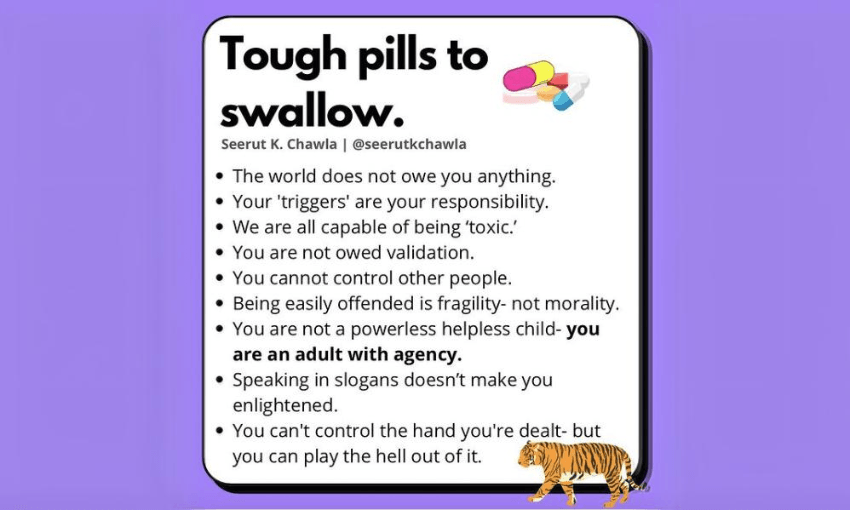Don’t let a relapse into treatment culture keep you from getting treatment
The wave is turning on Insta-therapy. Throwing is great, but the actual treatment is still good and worth doing.
If you’ve had a lot of therapeutic feedback – «you’re right», «thank you for holding the space», «I feel seen», «do the work», «respect my boundaries», «Are you in the right headspace to find information that can hurt you?«, self-absorption, self-confidence, vulnerability, narcissism, «My description», «my anxiety», «my anxiety» – now I have good news for you: the modern therapy culture is strong and rising.
This post is mostly based on me licking my finger and putting it in the air, but here’s some of the air I feel: last year, Time magazine announced that we will hit «peak therapy» and London Evening Standard marked «end of treatment talk». Freddie de Boer, a US-based writer who often decries «therapeutic maximalism»has written about its lack of grip on culture. Seerut K. Chawla, a London-based psychologist who criticizes «Insta-therapy», has a growing number of approx. 300,000 people on Instagram. And on our shores, Dr. Jonathan Shedler, a well-known psychoanalyst based in the US, continued. Kim Hill’s Saturday morning show in September of last year to discuss the clinical risks of overusing speech therapy.
My guess is that, given the pace of change in living conditions in Aotearoa and the rest of the world, we will have to endure a few more years of everything «working» and «in wake up» before we move. to a new method of post-treatment feedback. But as Insta-therapy is removed from our traditional home, it descends into the same waters as lolcats and ban-men womenI’m here to make one plea: don’t let the backsliding of treatment culture keep you from doing treatment.
I am curious to see the background of the therapeutic culture. The problems with it are many and have been well described by critics like Chawla and deBoer, but in short, the therapeutic culture encourages the person to enjoy the position of being a victim; seeing their mental health problems as a core part of their identity rather than challenges to overcome; and hold the people around them (and the world at large) accountable for meeting their needs and keeping them safe. The therapeutic culture breeds snowflakes and crybullies, and its preferred language is like an email from HR: saccharine and earnest, but also plainly threatening.
But as Chawla and deBoer are both careful to make clear, therapeutic culture is not the same thing as therapy. Often, the two are very similar and different. Therapy is a private meeting between patient and therapist, while the culture of therapy plays out on social media. Therapy is about overcoming the problem; therapy culture is claiming victimhood. Therapy has room for complexity, complexity and contradiction; therapeutic culture needs to fit into an Instagram carousel with a bullet. Therapy encourages you to find an internal locus of control; therapeutic culture tells you what the world should do for you. Therapy does not convert people; Therapy culture never closes.
If you confuse culture therapy for therapy, you may be running miles from both. That is a shame, and a mistake.
It may seem like we live in a nice, naby-pamby world where every man and his dog are shrinking, but the truth is, the vast majority of people don’t get treatment at any time. which one. Pākehā women were the group with the highest rates of treatment in New Zealand last year, but only 9.7% of them consulted a psychologist or counselor about mental health issues. mental health from June 2022 to June 2023, respectively Ministry of Health Affairs. For Pacific men it was 2.4%, and for Asian women 1.7%. (We are not outsiders: US details as of 2019 showed that 11.7% of women participated in counseling or therapy compared to 7.2% of men.)
Get out of the treatment culture, and you’ll see it’s a blip. Before that are decades of beliefs that medicine is for the weak, that doctors are quacks and weirdos, that people should be «man enough» to deal with their problems, and that the issues that arise in families should be dealt with alone. . Recent studies on New Zealanders’ attitudes towards treatment are scarce, but a 2021 survey of Americans found that 47% of respondents believed seeking treatment was a sign of weakness. 2021! America! Perhaps the beating heart of the therapeutic culture was collapsing all along.
I worry that a return to the treatment culture will cause these old beliefs about treatment to become stronger and re-emerge. Currently, the retreat encourages people to think about the culture of therapy do you selfishness. How many people will hear this as «therapy makes you selfish»? The feeling is already deep in the culture: in the books of Sigrid Nunez, the muttering of mothers, in the patient who is ashamed of himself, who cannot overcome the feeling that it is independent to be in bed at all. .
This is true of therapy: with good faith on the part of the patient and the necessary knowledge on the part of the therapist, therapy makes the patient stronger, less isolated, and better behaved over time. it’s still going. Therapy is not for the faint of heart. It takes a lot of courage: hour after hour of digging through the worst things that have ever happened to you and understanding their impact is not easy, to say the least. Therapy also requires (and breeds) humility and a focus on others: the work is not done if you do not shift the focus from the harm done to you, to the harm you inflict on others (and yourself). Therapy promotes responsibility and personal growth.
Remember this as it becomes uncommon to talk about «holding space», «awakening» and «visual impressions». Do not confuse treatment (good) with treatment culture (dispose well). Don’t throw the boundaries out with the bathwater.
#Dont #relapse #treatment #culture #treatment

